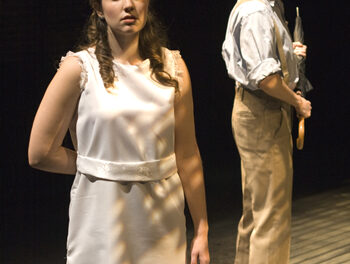Opera Carolina opened its season at the Blumenthal Performing Arts Center’s Belk Theatre with a sumptuous production of Charles-François Gounod’s Roméo et Juliette. Lavish sets, gorgeous Renaissance period costumes, and lively choreographies of both dance and fight scenes complemented the score. Gounod (1818-93), the leading composer of French opera in the third quarter of the 19th century, composed Roméo et Juliette in collaboration with librettists Barbier and Carré. Originally, the opera called for spoken dialogue; it was subsequently revised to include recitatives. The opera’s premiere at Léon Carvalho’s Théâtre-Lyrique on April 27, 1867, occurred during the International Exposition in Paris, a fortunate happenstance that no doubt facilitated its widespread fame.
The production featured the Opera Carolina Chorus, Gaston Rivero and Sari Gruber in the title roles, plus Philip Cockorinos (Friar Lawrence), Richard Novak (Tybalt), Donald Hartmann (Capulet), Diane McEwen-Martin (Stephano), Phillip Addis (Mercutio), Kim Blanchard (Gertrude), Charles Lang (Benvolio), Stephen Jepson (Gregorio), and John Fortson (Duke of Verona). James Meena débuted in the pit as conductor of the Charlotte Symphony. Jay Lesenger marked his Opera Carolina début as stage director. The choreographers were Martha Connerton (dance) and Dale Anthony Girard (fight scenes).
There was much to absorb and ponder. For starters, how well does Shakespeare translate into a 19th-century three-act opéra lyrique idiom, a stage spectacle filled with blocked choral presence, dance scenes, solo bravura arias, and whose dramatic pace has been slowed enough to accommodate all the music? After all, that which can be delivered briskly as theatrical monologues or dialogues accrues additional weight (and more time) when there are vocal and orchestral renderings of those same lines. Ever conscious of this reality, the librettist and composer make careful choices to allow for these shifts in timing and dramatic proportion, and the results are not always gratifying.
In essence, this opera forces the viewer into a parallel universe — one of Shakespeare’s day in dramatic content (including in this production Renaissance sets and costumes), and one of 19-century French musical tastes (naked vocal display, a significant choral presence, dancing, and at times, a banal reduction of Shakespeare’s immortal verse). The romantic danse du jour, the waltz, is everywhere in Act I; it’s how we meet Juliet in her opening aria “Je veux vivre.” And while there were dance movements reminiscent of the Renaissance pavane and galliard, there were many whirl-a-gig waltzing couples too, just as the composer intended. Another major departure was in the final scene in which Juliette awakens from her death-like sleep to encounter Romeo who, though poisoned, is still alive, and therefore available for one last duet.
The success of the production varied. The scenery was breathtaking and evocative, the staging and choreography were creative and dramatically convincing, the orchestra displayed thorough professionalism in ensemble and musicality. Mercutio’s Queen Mab ballad (“Mab, la reine des mensonges”) was masterfully executed with vigor and vocal assurance. Juliet had her ups and downs — the ups in the tender exchanges with Romeo, the downs in her high register where the pitch faltered, or as in her Act III, scene 1 air “Dieu! Quel frisson court dans les veines!” where she was audibly straining. Romeo was more consistent in his technical prowess. His cavatina “Ah! Lève-toi, soleil,” sung beneath Juliet’s balcony, provided an especially beautiful sonorous image of Juliet as the rising sun. Capulet’s singing consistently lagged behind the orchestra. Friar Lawrence’s vocal timbre, round and resonant, matched music with character perfectly. In the added trouser role as the mocking Montague page, Stefano delivered a healthy dose of insult in a shimmering and facile soprano range. Kudos to conductor James Meena for his excellent musical direction and for the translation of the libretto into supertitles which included, where possible, lines from the Shakespeare play.
The company’s season continues with Aida, Don Giovanni, Die Fledermaus, a holiday production of Amahl and the Night Visitors, and a Valentine’s Day tie-in, Love Notes. Visit http://www.operacarolina.org/.













